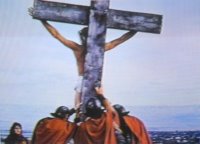 Johnny Cash's The Gospel Road: A Story of Jesus
Johnny Cash's The Gospel Road: A Story of Jesus was recently
re-released on DVD. Originally it was released in 1973, strangely one of three musicals based on the life of Christ that was released that same year - although this was the only one to create the feel of a documentary. Cash decided to produce the film a few years after his conversion to Christianity (largely omitted from the recent Cash bio-pic film
Walk The Line) in late 1967 / early 1968.
1 He subsequently met Billy Graham in 1970 and they teamed up with director Robert Elfstrom who had filmed Cash's 1969 biopic
Johnny Cash! The Man, His World, His Music (1969). Cash co-wrote the script along with Larry Murray, who went on to write for Cash's ABC Television shows.
The filming of the movie was relatively
ad hoc. In 1973 Cash was
interviewed by Country Music Magazine about the film, and recalled the way the film was made:
When we went to Israel we had two songs that we thought would probably be in the film...We hired an Israeli film crew to supplement our crew that we took over there, and we decided since we'd gone to all the expense to take a bunch of people to Israel that we were gonna shoot the moon, and we were gonna make as good a film and spend whatever it took for the month that we had to spend over there. And that's what we did. We hired extras. We didn't try to make a little big movie. We didn't try to make a Cecil B. DeMille film. We used as few extras as we could, and at the times when there should have been a multitude of people, we didn't use anybody. We used sound effects, to try to make it seem like there was a multitude of people. Well, when we came back and started editing the film and putting it together, we saw the need of a song to help tell the story here and there.
Furthermore, the decision to cast director Robert Elstrom as director was only made the day before filming
2. It was perhaps a rash decision. All the good work of authentically filming the documentary in the Holy Land, was undone by this ultra-blond Jesus, the lightest-haired Jesus ever committed to celluloid. Elfstrom's acting was weak too, and never really created the empathy that the role usually acquires.

That is not to say it is an entirely poor portrayal. Elfstrom's Jesus is as beatific as they come, and has clearly been very influential. The scenes of him playing with a group of children on the beach to the tune of Joe South's "Children" would set a standard that other smiley Jesus films, notably those made by more conservative Christians, would aspire to. In particular, the 1979
Jesus film, the Visual Bible's
Matthew and the 1999
Jesus mini-series all appear to have been influenced (perhaps indirectly) by this film.
Actually the film both draws on older Jesus films as well as influencing later films, although many of these may well be coincidental. Since this film and Jesus Christ Superstar were made at the same time it must be an accident that both films are made in Israel and combine a mixture of historical and contemporary commentary. That said the scene of the woman caught in adultery must surely be influenced b DeMille's 1927 epic - in both films when Jesus writes on the ground he is writing the sins of those standing nearby. The final scene where Jesus is reconciled to his disciples on a beach is reminiscent of the ending of
King of Kings (1961). In terms of possible influence, Mary Magdalene (June Carter Cash) is the only
character in the film we hear speaking, when she retells her first meeting with Jesus. Another popular female singer, PJ Harvey, would reprise the role in
Book of Life (1998) and similarly give an account of her conversion experience.
The role of Carter Cash in this movie is interesting, both given how she was viewed at the time and her role in
Walk The Line. As
Lesa Bellevie notes
I can understand to some degree why June Carter Cash would have wanted to play Mary Magdalene on film. Judged harshly for her divorces, perhaps she felt some kinship with the haunted Mary Magdalene whose sexuality had become the focus of her entire existence.

There are a number of interesting points in relation to this. Firstly, probably the majority of Jesus films have combined Mary Magdalene with the woman caught in adultery in John 8. By contrast,
The Gospel Road shows that incident but uses a different actress, and when it comes to Magdalene's speech stresses the seven demons aspect. Secondly, in light of the
Da Vinci Code, it is hard to resist looking whether a particular Jesus films suggest some form of romantic interest between Magdalene and Jesus, and in this case, the casting of the producer's wife in the role is somewhat suggestive. Finally, in
Walk The Line she is cast as Johnny's salvation, and so it is interesting that this film is, to an extent, examining her salvation.
Like the other 1973 Jesus Musicals (
Jesus Christ Superstar and
Godspell) the film has dated terribly, and much of it seems twee and bland today. Even in it's own day it was probably the safest of the three films.
Godspell was a bold re-contextualisation which dared to show Jesus as a clown. Whilst
Superstar was also set primarily in the past, it used Rock music rather than the "safer" country music of Cash.

That said the film has a number of strengths that are often overlooked. The use of natural light, and voiceless characters give the film a naturalistic cine-camera feel which feels less about a performance, or a DeMille-like spectacle, and more about genuine faith. Despite the fact that we generally do not hear the characters speak, we are drawn closer to them, and relate to them more freely. The movie has a "from the heart" feel which is generally lost in Jesus films. It serves as a testament to Christian faith from that era, no doubt due to it being Cash's labour of love.
The natural light effect is emphasised by the low camera angles and inclusion of the rising or setting sun in many scenes. Whilst the deference implied by such low camera work has been discussed elsewhere, these scenes also introduce a simplistic beauty into the film.
Another strength is the space that the movie creates. Given a tiny budget (from Cash's own pocket), the film uses only a few extras who are sparsely distributed around the various locations. In the quote above, Cash notes how at the times where there was a requirement for a multitude they went to the opposite extreme and had no-one present yet used the sounds of a multitude. This creates an eerie effect placing the viewer at the centre of events.

Such budgetary limitations were no doubt also part of the decision to depict the three trials of Jesus all at the same time. Herod, Pilate and Caiaphas stand in adjacent arches and Jesus moves from one to the other. This crystallises the often confusing sequence of events into a single moment. The three stand together, and Cash's narration cleverly draws out how each represents a particular grouping.
Perhaps the film's strongest moment is the crucifixion where the camera first encircles the dying Jesus, before cutting to a number of close ups which gradually pan out to reveal a modern location (see top picture). The focus of these scenes, like the film in general is very much on the "gospel" road of faith, rather than on historical reconstruction or exploration like the majority of other Jesus films. This has infuriated some, whilst inspired many others. One assumes these reactions are more in the past than the present. The years have dulled the impact of the film, and left itself something of a historical artefact - a monument to Johnny Cash's faith.
------
There's another review at
Film Brain, plus
my earlier comments on the film1 - Dave Urbanski, "The Man Comes Around: The Spiritual Journey of Johnny Cash", p.67-73, Lake Mary, Florida, Relevant Books (2003)
2 - ibid p.113Labels: Godspell, Gospel Road
 Over at NT Weblog, Mark Goodacre has been writing quite a lot about the Gospel of Thomas recently. His latest post in the series is looking at clips from the 1987 Channel 4 documentary The Gnostics and in particular he discusses it's dramatisation of the Jesus of the Gospel of Thomas. The most blatant observation is just how blond haired and blue-eyed this Jesus is. There are a couple of interesting points on that issue alone.
Over at NT Weblog, Mark Goodacre has been writing quite a lot about the Gospel of Thomas recently. His latest post in the series is looking at clips from the 1987 Channel 4 documentary The Gnostics and in particular he discusses it's dramatisation of the Jesus of the Gospel of Thomas. The most blatant observation is just how blond haired and blue-eyed this Jesus is. There are a couple of interesting points on that issue alone. 

























